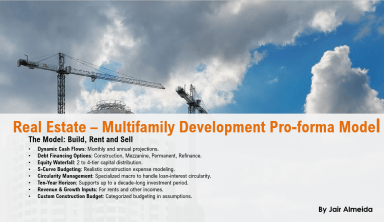
Last version published: 27/02/2024 08:31
Publication number: ELQ-37109-13
View all versions & Certificate

Real Estate Multi Family Development Excel Model
The real estate model provides a comprehensive tool for evaluating multi-family property investments with dynamic cash flow analysis and flexible financing.
Further information
Evaluate the feasibility of a Multi-familiar property development project (with lease-up and selling options) from an investment/investors point of view, taking into account various parameters such as operational, leverage capital expenditures, equity structure, etc..
Real Estate Development of a multi-familiar project, with some slight adaptation, can also be applied to other real estate investments.
Does not work well for non-real estate businesses.














